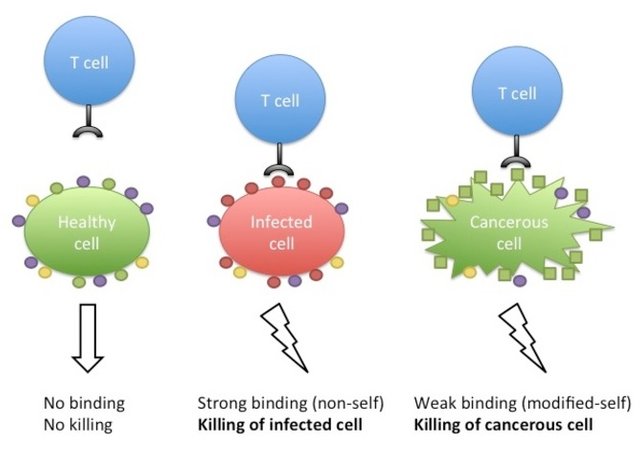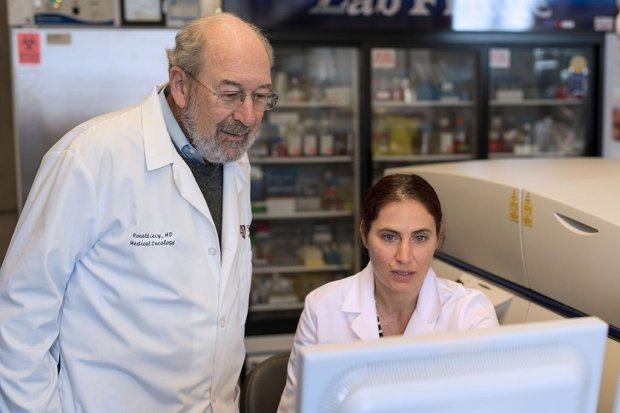Helping our own bodies to fight cancer: A new anti-cancer vaccine that might put an end to it.
Tired of hearing about a “potential cure for cancer” every other week only to see no follow up? Me too. Every now and then emerges a new cancer fighting strategy that somehow never becomes fully successful or widespread.

When a friend pointed this one to me, about an “anti-cancer vaccine”, I was skeptical. However, after reading the scientific report about it, I am more excited that I have been in a long time! This could be it, seriously.
One of the greatest caveats in the fight against cancer is its complexity, since “cancer” is not a single disease –as many of us could assume– but rather a myriad of diseases with different causes, prognoses and responses to treatment that are grouped together because they share the common characteristic of uncontrolled cell growth.
The Holy Grail of cancer research then, would be to find a way to combat a common characteristic to all kinds of cancer. In order to find this Holy Grail, we can start by taking into account some important points:
Our bodies can fight cancer using our immune system.
Perhaps the most fundamental function of our immune system is the ability to distinguish between normal cells that belong to our body and abnormal (cancer, or virus-infected) or foreign cells (for example, pathogens) that are potentially dangerous and therefore need to be disposed of.
All cells in our bodies are regularly presenting little bits of proteins (or other molecules) on their surface as “proof of identity” for the immune cells to recognize as they patrol the human body. However, the onset of cancer usually produces an aberrant assortment of these “proof of identity” proteins that are then recognized by the immune system as abnormal (imagine it like the cancer cells showing the immune cells an obviously forged identity card). This “rings the alarm” to activate the adaptive immune response which then attacks the cancer cells and eliminates them.

If our immune system can fight cancer by itself, then how come people still need to undergo treatment, or end up dying from the disease?
There are several factors that make the task of eliminating cancer cells from our body more difficult. One of them, is that as cancer cells start to proliferate and grow, they also start developing strategies to avoid being detected by the immune system (the cancer cells evolve into a kind that is more difficult to deal with).
Also, when it comes to a solid tumor, the cells closer to the surface will be more accessible to become recognized and infiltrated by immune cells, while the cells near the core are protected from their action.
Still, since this approach comes close to the “holy grail” goal of finding a single way to treat all types of cancer, scientists have invested great efforts into finding ways to optimize it.
One of the cutting edge strategies for this is the use of CAR T cells: These are immune cells (T cells, which are the main “killer” cells in our bodies) that have been genetically modified in order to “boost” their ability to recognize and destroy cancer cells. This strategy was recently approved by the FDA for treatment of lymphoma in humans.
While the results have been pretty spectacular, it has the downside of it being very costly and time consuming, given that in order to produce these modified T cells they have to:
- Extract the immune cells from the patient.
- Genetically engineer such cells in the lab.
- Test the modified cells for efficacy.
- Finally get reintroduced into the patient so they can attack the cancer.
Moreover, one risk observed in the CART T cell approach is that sometimes the modified cells are too aggressive and they start attacking other normal cells in the body as well.
Remember about how cancer cells evolve to become harder to kill by the immune system? Well, one of the ways they do that is by producing molecules that inhibit or block the action of the immune cells that are supposed to dispose of them.
Therefore, another interesting approach that some scientists have employed is the use of substances (usually antibodies) that remove the “breaks” created by cancer cells that are trying to shut down an immune response. This approach has worked well but has also some disadvantages: these substances are usually applied in a systemic way (meaning, they are circulating all over your body) and therefore there is a possibility that they cause autoimmune toxicities―meaning that the ability to avoid destruction of normal cells by their own immune system can be overridden by the treatment because all blocks have been removed.
Here is where the work of Ronald Levy and Idit Sagiv-Barfi from Standford University comes to propose a novel and very clever solution: what if we inject the immune booster substances directly in the tumor?

A targeted attack: Injecting immuno boosters into a cancer tumor?
A couple of immune boosting agents were injected directly into a single tumor of each of the affected mice used in the trial. Each of these agents had a specific function: one of them (called a CpG oligodeoxynucleotide) stimulated the expression of an important immune regulator molecule (OX40) that T cells produce in their fight against tumors. The other, an antibody recognizing OX40, helped regulate the fighting activity of the T cells by stimulating the attack of tumor cells while also preventing the premature shutting down of such cancer-killing activity.
After application of the combination of immune boosters directly into the tumor, the killing T cells from the mouse’s immune system got activated and the tumor was targeted and eliminated by them, without the use of conventional chemotherapy, radiation or any other conventional approach. Positive results were achieved eliminating both tumors that were transplanted into healthy mice, as well as tumors naturally developed by mice (such mice are genetically modified to be prone to develop a certain kind of cancer).

And that is not even the coolest part of it! By injecting the boosters directly into the tumor, they stimulate the T cells that have already recognized and infiltrated that certain tumor. This means that they don’t have to figure out the identity of the antigen (the “signal”, so to say) that alerts the immune cells that such cells are abnormal, since the T cell already recognized it. All they have to do is boost their activity to make their killing much more effective.
That serves to bypass a major hurdle that has put a block into cancer research: the search for cancer-specific antigens that can be recognized by the immune system. Truly amazing results, but the best is yet to come as we progress into the article.

To understand the next part, we need to take into account the fact that our immune system keeps copies of the useful T cells that recognize either pathogens or malignancies, for further use (thanks evolution!).
Which opened the question: Could these activated cells, which were selected for recognizing a particular tumor, be able to kill the same kind of tumor found in a different part of the body? The answer was a resounding yes.
Finding a way to overcome metastasis.
Metastasis, which is the ability of cancer cells to migrate from a tumor to invade other parts of the body is one of the adaptations that make cancer so resistant and difficult to deal with. It is the reason why the cancer “comes back” after it had apparently been eliminated: because some rogue cells managed to escape destruction and establish themselves in another hidden part of the body, re-initiating tumor development.
This is where this cancer vaccine comes with the promise of saving the day: since the specific T cells that can recognize and eliminate the original tumor are still there circulating within the patient, whenever a new tumor of the same kind arises from rogue cells all that needs to be done is to inject a further round of boosters, so the T cells specific for it are stimulated to find the new target and destroy it as well.
In a nutshell, there are many advantages to this new cancer vaccine approach:
- It makes use of the patient’s own immune system, without having to genetically modify their cells.
- Since the injection is done directly in the tumor, the amount in which the booster agents are used is too tiny for it to have significant side effects somewhere else in the body.
- No need to spend lots of time and effort identifying a cancer-specific signal, since the immune cells infiltrated in the tumor already did that job!
- Given its high specificity (the resultant T cells only recognize and attack that particular tumor), there are no problems with autoimmune effects.
- The activated T cells are kept in the patient’s immune repertoire, so any further emergence of the cancer (metastasis) can be identified and eliminated, theoretically during the entire lifespan of the individual.
So far, this was successfully applied in mice with astonishing results: out of 90 mice used in the trial, 87 were cured. The strategy was also tested in vitro (outside the human body) using human cancer cells with similarly positive results.
The next step is to initiate a clinical trial with real cancer patients to assess its medical success, and the researchers in charge of the study are planning on doing the first clinical trial by recruiting 15 patients with lymphoma in order to put their strategy to the test.
Could we be on the edge of a revolution in the fight against cancer? Very exciting and promising times are ahead!

--------------------------------------------------------------------------------
Sources:
- Original Research article: Eradication of spontaneous malignancy by local immunotherapy (Science Translational Medicine - 31 Jan 2018)
- Cancer Vaccine Eliminates Tumors in Mice - Standford Medicine
- With FDA Approval for Advanced Lymphoma, Second CAR T-Cell Therapy Moves to the Clinic
Being A SteemStem Member
Vitamine B 17 it is claimed to be good for healing
Who develeoped this specific therapeutic agent, Kite Pharma I suppose?
As I've already told @suesa at some point, CAR-T cells are the "machine learning" or "blockchain" of medical research, everybody has them in their pipeline :D
Almost everyone are aware that cancer is a deadly disease, but most people ignorant and negligence is killing most people. With the above information and recent developments, I think everyone should know the importance of immunization and what they need to do in order to over the cancer cells.
great post any idea when testing will begin?
@irime so happy to heard bout this vaccine. My grandparents was die because of cancer. Doctor said I'm in a cancer high risks family. This vaccine will be able to help alot of people....Thanks for sharing 😘😘😘
great post @irime ♡ thank you for sharing
Hello irime!
Congratulations! This post has been randomly Resteemed! For a chance to get more of your content resteemed join the Steem Engine Team
my uncle died from cancer
To hear the speech version of this post click the play image.

Brought to you by @tts. If you find it useful please consider upvote this reply.
Very informative post!